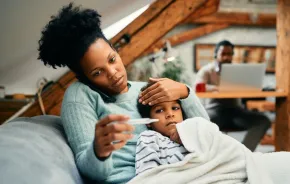 During the past year, I’ve often looked at my 11-year-old daughter as if we were meeting for the first time. She seems different to me; she is growing up both quickly and slowly. How can I mark this new stage and continue to grow our relationship? In our fast-paced First World country, what modern traditions and rituals are available?
During the past year, I’ve often looked at my 11-year-old daughter as if we were meeting for the first time. She seems different to me; she is growing up both quickly and slowly. How can I mark this new stage and continue to grow our relationship? In our fast-paced First World country, what modern traditions and rituals are available?
“In old traditional culture, you go from child to adult, and there is nothing in between, so it makes sense to celebrate adulthood. In modern western culture, there is a huge delay between reproductive maturity and social maturity,” says Rob Lehman, M.D., cofounder of Great Conversations, which offers classes and presentations on topics such as puberty, sexuality and parenting. “What are we actually celebrating? At the classic bar mitzvah when the kid is 13, it’s ironic to say, ‘You are now a man.’ It’s reflective of an older time.”
Maybe your family already has rich familial, cultural or religious traditions in place to mark your tween’s transition from childhood or your teen’s passage to adulthood. But if you’re seeking more ceremonial acts and activities, like I am, here’s a primer on some of the latest rituals out there, along with advice from parenting experts.
Ask and create
Jessica B. Gillooly, Ph.D., author of Before She Gets Her Period, researched how girls want to mark the beginning of menses. “They told me, ‘Don’t say, Congratulations, you are a woman! We are not women.’ But they did want it recognized [by] a lunch or a dinner, a picnic or a hike, or a small piece of jewelry.”
Julie Metzger, the other cofounder of Great Conversations, says a lot of families are excited about celebrating the changes that take place during this time of life. She recommends acknowledging the event you want to mark, offering your ideas for a celebration and asking your children for their input. “There is no single have-to-do thing. It’s about thinking, then saying with your actions, ‘I choose this relationship with you. I value who you are and who you are becoming,’” Metzger says. She adds that time together is precious, whether that means a meal out to celebrate your daughter’s first period, talking about the day while lying on your child’s bed, or planning a mother-son or father-daughter date.
Engage in regular family time
“Studies show that when communication between parents and teens is strong, teens tend to delay high-risk behavior,” Metzger says. “The culture [and] media communicate that teens don’t want to be with their families, but kids look to connect with parents on many levels — [they] enjoy sharing time with their family. Data shows that any adult investing in a child impacts that child’s confidence [and] esteem and delays high-risk behavior. Grandparents, teachers and coaches all have a role in investing in kids.”
Take this idea a step further and try an activity that neither you nor your child already does well. “The shared story is how we overcame an obstacle, and it’s less about being an expert,” Metzger says. “It’s fun when there are two of you and a goal, and you can both be a little nervous. Teens are looking for the stimulation of life, and you are entering into it together.”
Send kids to camp, let them help plan trips
 Lehman says as a young child, he didn’t have any input on family trips; but as he grew up, his dad let him help with planning. “It was a learning thing: Can you get us from here to there? But it was also a way of becoming an integral part of a family, and not just being a kid who is told where to go and what to do.”
Lehman says as a young child, he didn’t have any input on family trips; but as he grew up, his dad let him help with planning. “It was a learning thing: Can you get us from here to there? But it was also a way of becoming an integral part of a family, and not just being a kid who is told where to go and what to do.”
Camp is another means of encouraging and celebrating independence. “Most kids do not look forward to pubic hair, and they hate the idea of having to shave and smell, but they do look forward to getting some adult privileges,” Lehman says. “The whole idea of camps is to enable the child to thrive in a protective atmosphere away from parents. There can be a lot of growth at those times.”
Step up volunteer engagement
Let your tween or teen help decide where and how she — or the entire family — is going to give back to the world. Consider a family trip centered on volunteering, or send your child on his own volunteer adventure.
Create a coming-of-age circle
Anacortes resident Sommer Carter created a multigenerational coming-of-age circle for her daughter and a group of tweens and teenagers. They meet four times a year, during the equinoxes and solstices, to spend time exploring the natural world, seeing what’s in bloom and talking about how those items can be used for women’s health. They also spend time sitting together and listening to personal stories of their grandmothers and mothers, along with ancient myths and legends.
“We are all looking for connection, and the girls are seeking a pathway to womanhood, too,” Carter says. “But it’s also about being in that comfortable place where we can laugh.” She uses Janet Lucy and Terri Allison’s book Moon Mother, Moon Daughter as her guide.
Edmonds-based leadership coach Debbie Daniels also helps her clients create coming-of-age ceremonies. A recent ceremony marked the end of nine years of school together for a group of eighth-grade girls, as well as the beginning of a new phase in their relationships and lives.
Model the good parts of adulthood
Lehman says we often tell our kids the downsides of adulthood, such as a difficult workday or the troubles of the world. “Grown-ups should try telling their children three terrific things about growing up. Hearing those things from the most trusted adult in their lives can mean a lot to preteens and teens worried about their future,” he says. “Don’t make it general, make it specific: [Here’s] what is good to me about being an adult.” Your teen may still roll his eyes when you mention the possibility of celebrating his first shave. But if he knows you love your job, maybe growing up won’t sound like such a raw deal.
As for my tween, she and I are planning mother-daughter bike rides as the weather warms up. Because I haven’t ridden since I was pregnant with her, she looks forward to showing me everything she knows about biking in our busy city — celebrating our own little rite of passage as the student becomes the teacher.











